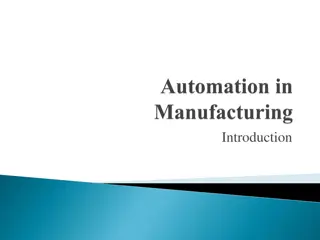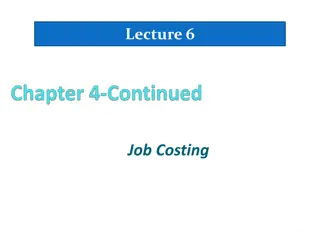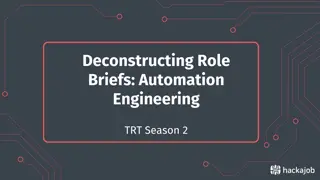AUTOMATION IN MANUFACTURING (MEC-401A)
Automation in manufacturing, led by electronic, mechanical, and computer-based systems, enhances productivity and quality by minimizing human intervention. Reasons for automation range from cost reduction to improved safety and product quality. Production systems encompass manufacturing support facilities and equipment, highlighting the importance of human labor alongside automation.
Download Presentation

Please find below an Image/Link to download the presentation.
The content on the website is provided AS IS for your information and personal use only. It may not be sold, licensed, or shared on other websites without obtaining consent from the author.If you encounter any issues during the download, it is possible that the publisher has removed the file from their server.
You are allowed to download the files provided on this website for personal or commercial use, subject to the condition that they are used lawfully. All files are the property of their respective owners.
The content on the website is provided AS IS for your information and personal use only. It may not be sold, licensed, or shared on other websites without obtaining consent from the author.
E N D
Presentation Transcript
B.Tech. 7th Semester AUTOMATION IN MANUFACTURING (MEC-401A) Unit-1 Dr. Mukesh Kumar Assistant Professor (Guest Faculty) Mechanical Engineering Department
AUTOMATION Defination: Automation can be defined as a technology concerned with the application of electronic, mechanical and computer- based systems to operate and control the production.
Automation To perform a task ,without human intervention to improve the productivity and quality . CNC Machines, Automated guided vehicles, robotsetc
Reasons for automation 1. To reduce labor cost. 2. To mitigate the effects of labor shortages. 3. To reduce or eliminate routine manual and clerical tasks. 4. To improve worker safety. 5. To improve product quality 6. To reduce manufacturing lead time. 7. To accomplish processes that cannot be done manually. 8. To Increase labor productivity.
Production Systems - That are used to manufacture products and the parts assembled into those products. - Production system is the collection of people equipment and procedures organized to accomplish the manufacturing process of a company.
Production systems can be divided in two categories: Manufacturing support systems Facilities : Factory Equipment
Facilities The facilities of the production consist of the factory, the equipment in the factory and the way the equipment is organized.
Manual labor in production system Is there a place for manual labor in the modern production system? The answer is yes. Even in a highly automated production system, humans are still a necessary component of the manufacturing enterprise. The discussion of the labor issue is separated into two parts, corresponding to the previous distinction between facilities and manufacturing support: (1) manual labor in factory operations and (2) labor in manufacturing support systems.
Automation Principles and Strategies Automation is not always the right answer for a given production situation. A certain caution and respect must be observed in applying automation technologies. Three approaches for dealing with automation projects 1. USA Principle 2. Ten Strategies for Automation and Production Systems 3. Automation Migration Strategy
USA Principle 1. Understand the existing process 2. Simplify the process 3. Automate the process USA approach is applicable to nearly any automation project
Understand the existing process The first step in the USA approach is to comprehend the current process in all of its details. What are the inputs? What are the outputs ? What exactly happens to the work unit between input and output? What is the function of process? How does it add value to the product? What are the upstream and downstream operations in the product sequence, and can they be combined with the process under consideration?.
Simplify the process Once the existing process is understood, then the search can began for ways to simplify. This often involves a checklist of questions about the existing process. Unnecessary steps can be eliminated without detracting from the function.
Automate the process Once the process has been reduced to its simplest form then automation considered. The possible form of automation include those listed in the ten strategies.
Ten Strategies for Automation and Production Systems Automation seems a feasible solution to improving productivity, quality, or other measure of performance then the following ten strategies for these improvements discussed. 1. Specialization of operations: The first strategy involves the use of special-purpose equipment designed to perform one operation with the greatest possible efficiency. This is analogous to the concept of labor specialization. Which is employed to improve labor productivity. 2. Combined operations: Production occurs as a sequence of operations. Complex parts may require dozens, or even hundreds, of processing steps. The strategy of combined operations involves reducing the number of distinct production machines or work stations.
3. Simultaneous operations: A logical extension of the combined operations strategy is to simultaneously perform the operations that are combined at one work-stations. In effect two or more processing (assembly) operations are being performed simultaneously on the same work part. 4. Integration of operations: Another strategy is to link several work stations together into a single mechanism, using automated work handling devices to transfer parts between stations. 5. Increased flexibility: This strategy attempts to achieve maximum utilization of equipment for job shop and medium value situations by using the same equipment for a variety of parts. 6. Improved material handling and storage: A great opportunity for reducing non-productive time exists in the use of automated material handling and storage systems.
7. On-line inspection: Inspection for quality of work is traditionally performed after the process is completed. This means that any poor-quality product has already been produced by the time it is inspected. 8. Process control and optimization: Manual control to automated control by optimization we can give the best parameters. Then the individual process can be reduced. 9. Plant operation control: Those which are not related fabrication process, each division specify automate. Business functions, product design. 10. Computer- integrated manufacturing: Input from market delivery to the final customer every operation is integrated to the computer. Business functions, product design etc ..
Manufacturing and Product Manufacturing can be defined as the application of physical and/or chemical processes to alter the geometry, properties, and/or appearance of a given starting material to make parts or products. Manufacturing also includes the joining of multiple parts to make assembled products.
Alternative definitions of manufacturing: (a) as a technological process and (b) as an economic process.
Manufacturing operations For converting raw material to finished product There are four activities. 1. Processing and assembly operation 2. Material handling 3.Inspection and testing 4.Coordination and control
Manufacturing operations Classification of manufacturing process
Product Facilities A manufacturing company attempts to organize its facilities in the most efficient way to serve the particular mission of each plant. The quantity of parts and/or products made by a factory has a very significant influence on its facilities and the way manufacturing is organized. Production quantity refers to the number of units of a given part or product produced annually by the plant. It has three types 1. Low production: Quantities in the range of 1 to 100 units 2. Medium production: Quantities in the range of 100 to 10,000 units 3. High production: Production quantities are 10,000 to millions of units.
a) b) c) d) Fixed-position layout Process layout Cellular layout Product layout Various types of plant layout
Fixed-position layout : Workers and processing equipment are brought to the product, rather than moving the product to the equipment .This type of layout referred to as fixed-position layout. Process layout: The individual parts that comprise these large products are often made in factories that have a process layout.
Cellular layout: The term cellular manufacturing often associated with this type of production. Each cell is designed to produce a limited variety of part configurations. That is the cell specializes in the production of a given set of similar parts or products according to the principles of group technology. Product layout: The collection of stations is designed specifically for the product to maximize efficiency.
Types of facilities and layouts used for different levels of production quantity and product variety
Basic elements of an automation system An automated system consists of three basic elements: (1) power to accomplish the process and operate the system. (2) A program of instructions to direct the process. (3) a control system to actuate the instructions.
Advance Automation Function, 1.Saftey Monitoring. 2.Maintence and Repair Diagnostic. 3.Error Detection and Recovery.
What is a Robot The difference between a robot and a manipulator Run by a computer or microprocessor not a human Controlled by feedback devices Mostly autonomous
What is a Robot ? Random House Dictionary A machine that resembles a human being and does mechanical routine tasks on command. Robotics Association of America An industrial robot is a re-programmable, multifunctional designed to move materials, parts, tools, or specialized devices through variable programmed motions for the performance of a variety of tasks. manipulator
What is a Robot ? A manipulator (or an industrial robot) is composed of a series of links connected to each other via joints. Each joint usually has an actuator (a motor for eg.) connected to it. These actuators are used to cause relative motion between successive links. One end of the manipulator is usually connected to a stable base and the other end is used to deploy a tool.
Classification of Robots - JIRA (Japanese Industrial Robot Association) Class1: Manual-Handling Device Class2: Fixed Sequence Robot Class3: Variable Sequence Robot Class4: Playback Robot Class5: Numerical Control Robot Class6: Intelligent Robot
Classification of Robots - RIA (Robotics Institute of America) Variable Sequence Robot(Class3) Playback Robot(Class4) Numerical Control Robot(Class5) Intelligent Robot(Class6)
What is Robotics History of Robotics 1922: Karel apek s novel, Rossum s Universal Robots, word Robota (worker) 1952: NC machine (MIT) 1955: Denavit-Hartenberg Homogeneous Transformation 1967: Mark II (Unimation Inc.) 1968: Shakey (SRI) - intelligent robot 1973: T3 (Cincinnati Milacron Inc.) 1978: PUMA (Unimation Inc.) 1983: Robotics Courses 21C: Walking Robots, Mobile Robots, Humanoid Robots
What are the parts of a robot? Manipulator Pedestal Controller End Effectors Power Source
Manipulator Base Appendages Shoulder Arm Grippers
Pedestal (Human waist) Supports the manipulator. Acts as a counterbalance.
Controller (The brain) Issues instructions to the robot. Controls peripheral devices. Interfaces with robot. Interfaces with humans.
End Effectors (The hand) Spray paint attachments Welding attachments Vacuum heads Hands Grippers
Controller (The brain) Issues instructions to the robot. Controls peripheral devices. Interfaces with robot. Interfaces with humans.
Power Source (The food) Electric Pneumatic Hydraulic
Robots degrees of freedom Degrees of Freedom: Number of independent position variables which would has to be specified to locate all parts of a mechanism. In most manipulators this is usually the number of joints.























